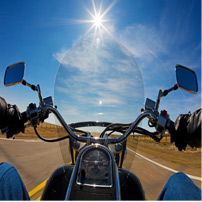The Top 5 Motorcycle Safety Tips
September 15, 2017 According to a recent report compiled by the Department of Transportation (DOT), there are 8,410,255 registered motorcycles across the United States. Rates of motorcycle fatalities increased by more than 8% between 2014 and 2015, and nearly 5,000 people die in fatal crashes every year. Although rates of motorcycle-related injuries have slightly decreased, almost 90,000 individuals are hurt annually.
According to a recent report compiled by the Department of Transportation (DOT), there are 8,410,255 registered motorcycles across the United States. Rates of motorcycle fatalities increased by more than 8% between 2014 and 2015, and nearly 5,000 people die in fatal crashes every year. Although rates of motorcycle-related injuries have slightly decreased, almost 90,000 individuals are hurt annually.
The Insurance Institute for Highway Safety (IIHS) reported that motorcycle crashes accounted for 15% of all the motor vehicle crashes that occurred in 2015. Motorcyclists are up to 27 times more likely to be involved in a crash than people in cars are. This is most likely a consequence of riders having less protection and being less visible to other vehicles on the roadway.
Although helmets are proven to save lives, not every state requires that riders wear them. IIHS data shows that helmets are 37% effective at preventing fatalities from occurring and protect people against brain injuries 62% of the time. Protection against brain injuries is especially important, because some of the most common types of motorcycle accident injuries include traumatic head injuries, road rash and bone fractures. If more states enacted legislation requiring riders to wear helmets, the number of fatal and permanent injuries occurring would certainly decrease.
Traumatic brain injuries and other kinds of head injuries are the leading cause of disability and death in motorcycle accidents. The DOT has documented not only that helmets lower the incidence of head and brain injuries, but also that they contribute to drastically reducing healthcare costs for victims who sustain serious injuries. Road rash is a quintessential motorcyclist injury that results from riders coming into contact with the surface of a road during an accident. Common symptoms can include skin abrasions and reddened skin; in more extreme cases, the skin can be completely removed, exposing layers of tissue and fat beneath.
Leg and arm fractures are among the most common bone breaks that riders sustain. Motorcycles are heavy and if they fall over, can easily crush a rider’s leg. Motorcyclists are also prone to fracturing their wrists or arms when they attempt to catch themselves while falling. To combat head injuries, road rash and bone fractures, the National Highway Traffic Safety Administration (NHTSA) urges motorcyclists to wear protective gear and to follow other safety tips. The administration reports that fatalities occur in as many as 80% of all motorcycle accidents, so taking as many precautionary measures to combat inherent user dangers is crucial.
Motorcycles are not only dangerous for their riders but also for other drivers due to the increased accident hazards they can create. As with all dangerous activities, being cautious and prepared can help to inhibit the risks. Some of the top safety tips from the NHTSA that help keep motorcyclists – as well as other drivers – safe are:
- Wear appropriate safety gear – a DOT-approved helmet, long-sleeved shirt/jacket and pants with abrasion-resistant fabric/armor, footwear that covers the ankles, gloves and a face shield;
- Be seen: lack of visibility is a major contributing factor in many accidents; wear light or white-colored helmets and reflective trim or tape;
- Make sure all head and taillights are in working order;
- Be careful. Always follow the rules of the road;
- Avoid speeding;
- Drive defensively – motorcycles are at a natural disadvantage in accidents with larger vehicles, and:
- Do not drink and drive
There are more useful safety tips from the NHTSA.
Accidents that are the result of speeding or drinking and driving are 100% preventable. According to the IIHS, speeding is an issue in 48% of fatal crashes – and at 42%, alcohol isn’t fair behind. Motorcyclists and other drivers can prevent these kinds of crashes from happening by never driving after drinking and following posted speed limits. Older riders should be particularly careful when operating motorcycles; data shows that individuals over 60 are up to three times more likely to require hospitalization after a crash.
To combat accident and fatality rates, many states offer low-cost or free motorcycle safety programs that detail training and defensive driving techniques to new, returning and experienced riders.
If you reside in New Jersey, please follow these steps.
Personal Injury Lawyers at Galfand Berger, LLP Pursues Recoveries for Individuals Injured in Motorcycle Accidents
If you or a loved one was injured or killed in a motorcycle accident, please contact our Philadelphia personal injury lawyers. With offices located in Philadelphia, Bethlehem, Reading and Lancaster, Galfand Berger serves clients throughout Pennsylvania and New Jersey. To schedule a consultation, call us at 800-222-8792 or complete our online contact form.
 Google Screened
Google Screened
